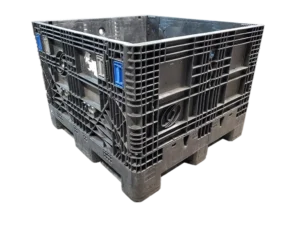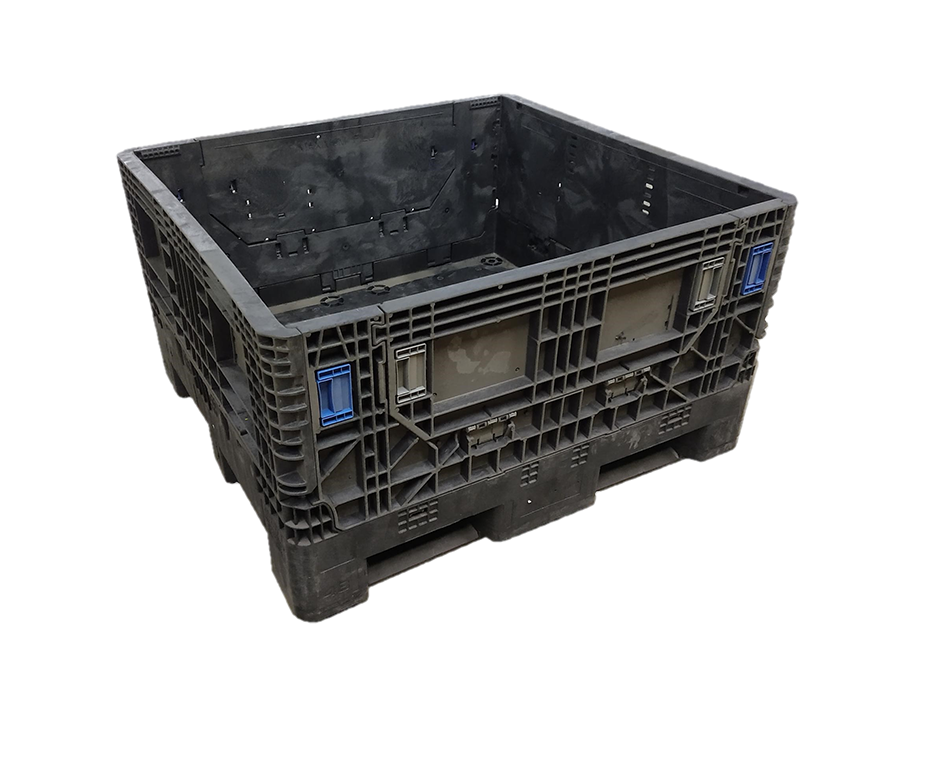Why used bulk containers are efficient for large-scale material management
Wiki Article
The Ultimate Guide to Choosing the Right Mass Containers for Your Service Needs
Picking the ideal bulk containers is critical for any service that counts on effective logistics. Numerous sorts of containers exist, each designed for details products and applications. Aspects such as dimension, product compatibility, and governing requirements play a significant function in this decision-making process. Understanding these components can bring about improved functional performance. Nevertheless, many services ignore vital aspects that could enhance their overall efficiency and sustainability. What are these factors to consider?Understanding Different Sorts Of Mass Containers
Mass containers function as crucial tools for companies seeking reliable storage and transportation remedies. These containers can be found in numerous kinds, each developed to meet specific functional requirements. One common type is the intermediate mass container (IBC), which is perfect for granulated and liquid products, using an equilibrium of capability and maneuverability. One more popular choice is the mass bag, or FIBC, ideal for completely dry, flowable products. These adaptable containers are light-weight and can be conveniently transported and stored. For heavier products, rigid mass containers are frequently employed, giving resilience and stability for secure handling. In addition, there are specialized containers tailored for hazardous materials, ensuring compliance with safety policies. Comprehending the unique attributes of these mass container kinds permits organizations to make educated choices that enhance logistics and reduce expenses. By selecting the right container, firms can enhance their operational efficiency and streamline their supply chain processes.Trick Material Factors To Consider for Bulk Containers
When selecting bulk containers, it is necessary to ponder the materials made use of in their building. Aspects such as chemical, resilience, and toughness compatibility play an important duty in making sure the containers fulfill details functional demands. Furthermore, weight and mobility problems can impact both performance and transport logistics.Material Durability and Toughness
Resilience and strength are important variables in selecting materials for mass containers, as they straight influence the container's capability to withstand various ecological conditions and managing procedures. Products such as high-density polyethylene (HDPE), polypropylene, and stainless steel are commonly preferred for their robust residential or commercial properties, supplying resistance to abrasion, temperature level, and influence variations. The selection of product also affects the overall life-span of the container; stronger materials usually lead to much less regular substitutes, causing set you back financial savings over time. Additionally, the weight of the product can influence delivery costs and simplicity of handling. Organizations must consider their particular functional settings and the potential for deterioration to assure peak toughness and toughness in their mass container option.Chemical Compatibility Variables
Recognizing chemical compatibility is essential for picking mass containers, as the materials used have to resist the certain compounds they will certainly hold. Numerous aspects influence compatibility, consisting of the chemical nature of the components, temperature, and period of storage space. As an example, harsh chemicals may require containers made from stainless steel or specialized plastics that withstand deterioration. Furthermore, reactive compounds can generate warm or gases, necessitating aired vent or pressure-rated containers. The choice of container product, whether polycarbonate, polyethylene, or metal, should straighten with the chemical homes of the stored compounds to avoid violations or leaks. Inevitably, a thorough analysis of these compatibility elements guarantees secure handling and storage space, safeguarding both employees and the environment while preserving item integrity.Weight and Portability Concerns
Picking bulk containers includes not just assessing chemical compatibility yet likewise taking into consideration weight and portability. Businesses should examine the simplicity of handling and transportation to maximize efficiency. Light-weight materials like high-density polyethylene (HDPE) or aluminum can promote easier motion and lower shipping expenses. Alternatively, heavier containers may provide improved durability however can impede flexibility, particularly in settings calling for frequent relocation. Furthermore, the layout of the container need to permit practical lifting and stacking, making certain ergonomic safety for workers. Firms need to also consider the infrastructure available for transport; as an example, containers compatible with forklifts or pallet jacks can enhance operations. Eventually, the ideal equilibrium in between weight and transportability straight affects functional efficiency and price efficiency.Sizing Your Mass Containers for Optimum Performance
When sizing mass containers, services should very carefully examine the measurements needed to suit their certain items. In addition, weight ability is a vital element that influences performance and safety and security throughout transportation and storage. Reliable sizing not just makes best use of area yet likewise enhances functional process.Figuring Out Container Capacities
Picking the appropriate dimensions for mass containers is crucial for maximizing efficiency in storage space and transport. Companies must examine their particular needs, thinking about aspects such as offered space, the nature of the items being kept, and the approaches of transport made use of. Exact measurements ensure that containers fit ideally in vehicles and stockrooms, lessening squandered space and minimizing dealing with time. Criterion sizes can offer ease, but personalized dimensions could be essential for distinct demands or to suit certain items. Additionally, it is very important to evaluate piling capabilities and access, as these aspects affect overall functional effectiveness. Inevitably, the ideal dimensions cause improved organization and streamlined logistics, benefiting the general efficiency of business.Weight Capacity Considerations
Comprehending weight capability is essential for organizations intending to maximize their bulk container efficiency. The weight capacity of a container straight affects storage space capacities, transport logistics, and total functional prices. Picking containers with the suitable weight limits ensures that organizations can securely save and deliver their items without risking damage or compliance concerns. Straining containers can lead to structural failings, while underutilizing capacity lead to wasted resources. It is essential for companies to examine their item weights and think about any type of regulatory requirements when picking containers. In addition, variables such as the kind of material, intended usage, and ecological conditions ought to also influence weight capacity decisions. By evaluating these components, organizations can enhance effectiveness and assure a structured supply chain.Regulatory Conformity and Safety Standards

Governing compliance and security criteria play a necessary function in the selection of bulk containers for organizations. Organizations should assure that their containers meet different laws set by local, national, and international authorities. These criteria frequently pertain to material security, architectural integrity, and appropriate labeling, which help stop crashes and guarantee the safe transport of products.
In addition, adherence to industry-specific standards, such as those from the Fda (FDA) or the Occupational Security and Wellness Management (OSHA), is vital for firms taking care of dangerous materials or food. Non-compliance can lead to penalties, lawful concerns, or damage to a company's credibility.
Companies must additionally take into consideration the container's compatibility with the materials being stored or transferred to prevent contamination or chemical responses (used collapsible containers). To summarize, comprehending and applying regulative conformity and safety and security criteria is crucial for the effective and responsible use bulk containers
Sustainability Options for Eco-Friendly Bulk Containers

Companies are additionally checking out options made from recycled products, which not just save sources however also sustain the recycling industry. Advancements in design allow for lighter containers that need much less energy to transportation, even more improving sustainability. By integrating these environmentally friendly mass container choices, services can demonstrate their commitment to environmental stewardship while meeting customer need for lasting practices. This change not just helps the earth however can also boost brand reputation and customer commitment.
Cost-Effectiveness and Budgeting for Bulk Containers
While several companies focus on sustainability, cost-effectiveness continues to be a critical variable when selecting mass containers. Organizations needs to evaluate the first purchase rate, along with long-term functional costs, to ensure financial practicality. Variables such as sturdiness, upkeep, and reusability play a considerable duty in establishing overall expenditures.Buying top notch containers might yield higher ahead of time prices but can cause cost savings via decreased replacement prices and lowered waste. In addition, companies must take into consideration transportation prices and storage space efficiency, as these can affect the total spending plan.

Regularly Asked Questions
How Do I Figure Out the Right Container for Hazardous Products?
To determine the ideal container for hazardous materials, one have to assess compatibility with the material, think about the container's product, check for governing conformity, and analyze ability and safety and security features to ensure appropriate handling and storage space.Can Mass Containers Be Custom-made for Details Products?
Yes, bulk containers can be customized for particular products. used collapsible containers. Numerous attributes, such as material, style, and dimension, can be customized to satisfy special needs, ensuring optimal security and performance for moving and keeping various productsWhat Is the Ordinary Life-span of Various Mass Container Kind?
The typical lifespan of mass container kinds differs; plastic containers last 5-10 years, metal containers refurbished bulk containers 10-20 years, and wooden containers typically last 3-7 years, depending upon usage, upkeep, and ecological problems.Exactly how Should I Clean and Maintain Mass Containers?
To cleanse and preserve bulk containers, one must routinely inspect for damages, eliminate residue, wash with appropriate detergents, wash extensively, and assurance proper drying out prior to storage. Complying with producer guidelines enhances durability and safety throughout usage.Are There Rental Options for Mass Containers Available?
Yes, many companies offer rental alternatives for mass containers, offering adaptability for businesses. These leasings can accommodate various requirements, allowing companies to take care of stock successfully without the dedication of purchasing containers outright.Resilience and toughness are essential aspects in picking materials for mass containers, as they directly affect the container's ability to stand up to various ecological conditions and managing processes. Recognizing chemical compatibility is important for picking bulk containers, as the materials made use of have to stand up to the particular materials they will hold. Comprehending weight capability is vital for services intending to optimize their bulk container performance. Governing compliance and security requirements play a vital function in the option of bulk containers for companies. While lots of organizations focus on sustainability, cost-effectiveness stays an important variable when picking bulk containers.
Report this wiki page